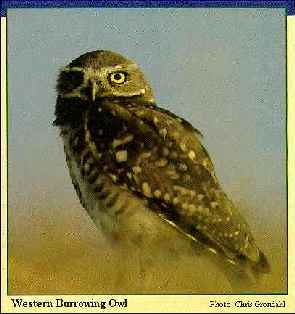
Hi there. Today you are going to learn all about me, the Burrowing Owl. My name comes from the Latin word "cunicularius" which I am told means beneath the ground, where I do spend a good deal of my time. Living in the ground makes me different from them other owls. I was spotted in Chile way back in 1782, long long time ago.
Oh I almost forgot some of my aliases are: Ground Owl, Prairie Dog Owl, Rattlesnake Owl, Howdy Owl, Tunnel Owl, Gopher Owl, Cuckoo owl (NO SMART REMARKS EITHER!) Johnny owl and the Hill Owl. I don't know why you humans feel it's necessary to give us all these other names to me it's just confusing and not at all necessary but if that's what makes you happy, go for it.
I am kind of a small guy weighing about 7 ozs. and growing to a little under a foot in length. I have a round sandy colored head with no ear tufts. I have pretty yellow eyes with white eyebrows. My back and upperparts of my wing are also sandy in color with creamy bars across my breast and belly. We are easy to see because, unlike our cousins we prefer the daylight and are a rather friendly bunch as long as you guys are nice to us. Some have described us as "short fat owls on stilts" because of our long legs, which we use to see over the grass.
Our favorite food consists mainly of beetles and grasshoppers. We have also been known to eat mice, gophers, young rabbits, and birds and even fruits and seeds. We can catch our prey like the grasshopper right on the ground or catch them in mid air like the flying squirrel, very talented wouldn't you say?
When we get ready to start our families we prefer the months or March or April. We are devoted mates and usually stay with one partner our whole life. We love to flirt by nipping and scratching at our intended and also bowing to her. To really show off we perform daring flights of rising to 100 feet in the air and hovering there for 5 or ten seconds and then dropping about fifty feet. Boy if you don't think that doesn't impress them. Our nests are underground and we fix them upwith dry leaves and twigs and stuff like that. Our females usually lay about six to nine eggs about a day apart and that usually takes about thirty days. When my young are born they can be seen looking out of the burrows as young as fourteen days looking for me to return with food. But usually they are a little over a month old before they are ready to pack up and move out.
Unfortunately, Burrowing owls are an endangered species. Since we prefer living
in open grassy areas instead of forests, we need to find existing burrows left over from burrowing animals. Cultivating has reduced our burrows and pesticides
have reduced the littl pests that we feed on too.
Thank goodness that steps are in place to help with the burrowing owl population.
Comments From Humans
Linda from Bolder Colorado, USA says that she has actually watched us doing little rain dances? She should know, because she's been watching us for years! Thanks, Linda.


|
..and for more...Previous Page The Barred Owl Next Page The Barking Owl Home return to home |